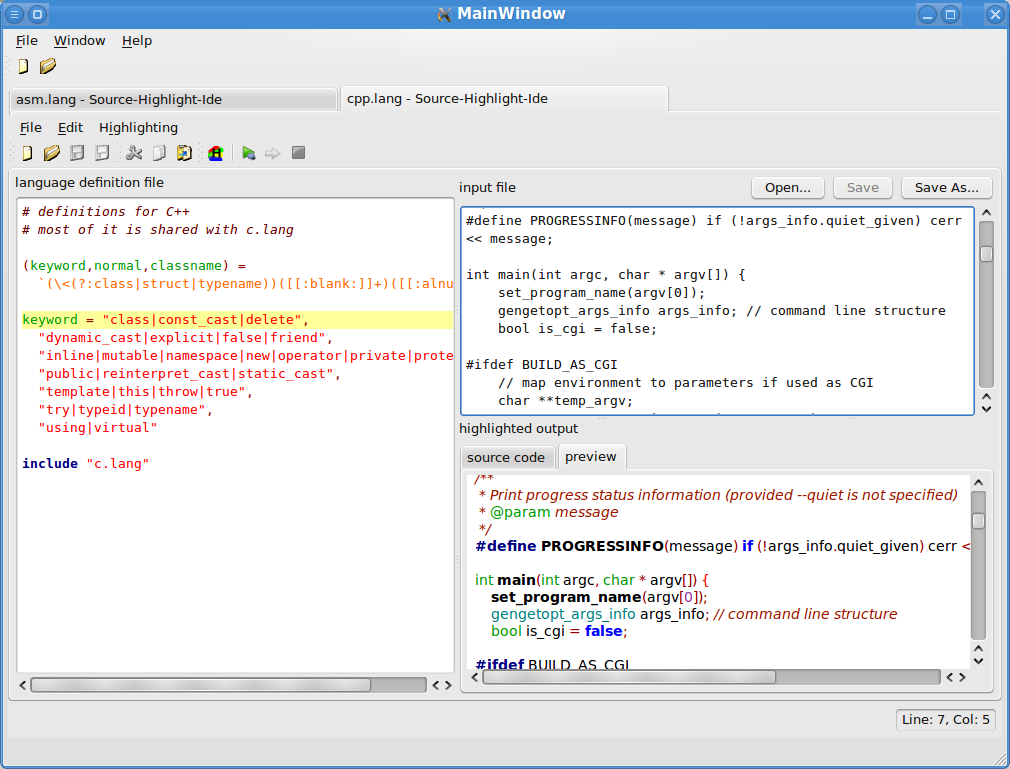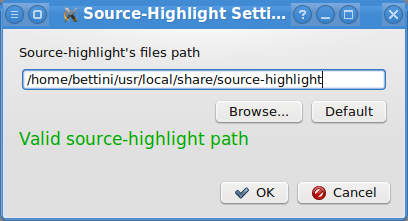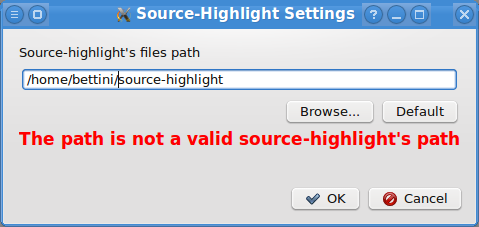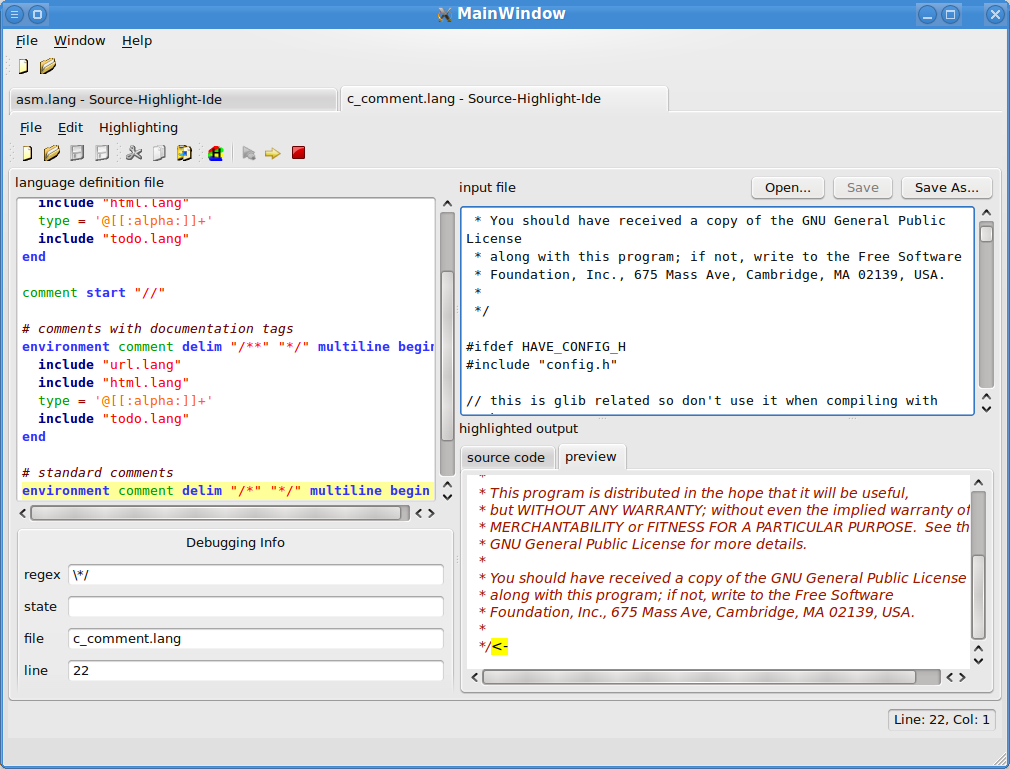SourceHighlightIDE - an IDE for GNU Source-Highlight
1.0
Sourcehighlightide is an IDE for GNU Source-highlight, http://www.gnu.org/software/src-highlite, (given a source file, produces a document with syntax highlighting); in particular, it is useful when you have to develop a new language definition file for source-highlight (Source-highlight reads source language specifications dynamically, thus it can be easily extended (without recompiling the sources) for handling new languages), modify an existing one, and, most importantly, debug a language definition file.

Source-Highlight-Ide main window
Project page
The official project page is hosted at http://srchighliteide.sourceforge.net/
License
Source-Highlight-Ide is distributed under the terms of the GNU GPL Licence.
Installation
To build it I suggest to create a separate directory, e.g., build cd there and run
qmake ../source-highlight-ide.pro make
Remember that you must have already installed the source-highlight-qt library.
The qmake project of Source-Highlight-Ide uses pkg-config, http://pkg-config.freedesktop.org (if this tool is installed in your system), to detect the library Source-Highlight-Qt (and implicitly also the GNU Source-Highlight library).
If you installed that in a standard place (e.g., /usr or in a system directory where ldconfig and pkg_config find it) then this should be enough.
Otherwise you must specify the directory where pkg_config can find the file source-highlight-qt4.pc and source-highlight.pc); note that source-highlight-qt4.pc will also contain the references to GNU Source-highlight library and headers, so you won't have to worry about that.
for instance, if you installed source-higlight-qt library in ~/usr/local, then the .pc file will be in ~/usr/local/lib/pkgconfig and you'll need to use this directory for setting PKG_CONFIG_PATH, e.g.,
PKG_CONFIG_PATH=~/usr/local/lib/pkgconfig/ qmake ../qsource-highlight.pro make
the executable binary will be created in the directory bin
If pkg-config is not installed in your system, you'll have to specify the LIBS and INCLUDEPATH qmake variables manually, using the correct path, for instance:
LIBS += -L~/usr/local/lib -lsource-highlight-qt4 INCLUDEPATH = ~/usr/local/include
You can also specify the name of the libraries to use by using SOURCE_HIGHLIGHT_QT_LIB, SOURCE_HIGHLIGHT_LIB, and BOOST_REGEX for source-highlight-qt, source-highlight and boost regex (used by source-highlight), respectively. This is useful if pkg-config is not installed in your system.
Once the building has sucessfully finished, you can install the files with the command make install; binaries will be installed into /bin and documentation (both html documentation and the one readable with qt assistant) into /share/doc/source-highlight-ide/html.
You can customize the root of the installation directory with the environment variable INSTALL_ROOT; for instance,
INSTALL_ROOT=$HOME/usr/local make install
You might need to become root if you install in a path different from your home.
Source-Highlight Settings
Source-highlight library uses a path (called data dir) to search for language definition file, output format definition files, style files, etc. This path must be set correctly otherwise highlighting features will not work. In a standard installation this path should already be set appropriately. However, if you use a non standard installation of source-highlight, this path might not be set correctly (a symptom is when you get errors when trying to perform highlighting, or a message box shows up when you run Source-Highlight-Ide).
You can set this path using the Settings -> Source-highlight Settings menu. This will bring a dialog where you can set the path (or choose it with the browse button); notice that the dialog also checks whether the currently selected path is a valid path for source-highlight.

correct settings

wrong settings
Tip:
In order to be a valid path, it should contain at least lang.map file and .lang, .outlang, .style files.
Basic Usage
Source-Highlight-Ide can be used as an editor for Source-Highlight .lang definition files (left text edit); moreover, an example input file can be opened (right text edit, top) that will be used to produce html highlighted output (right text edit, bottom); the highlighted output can be seen both in source format (html) and in a preview format.
This way, while writing the language definition file, it is also possible to check on-the-fly whether the output is the one expected. The highlighting can be performed by using the menu or the toolbar button:

Source-Highlight-Ide is a MDI application, thus, several .lang definition files can be opened.
Debug
Although you can use Source-Highlight-Ide for testing a language definition file while you're editing it, the feature that can be most useful is the debugging mechanism.
You start debugging by using the button "Debug", and then press "Step" for formatting element by element the parts of the input file that is to be formatted. You can interrupt the debugging by using the button "Stop".
During debuggin, the debugging frame will appear under the lang definition file text editor ("Debugging Info").
The debugging steps at each matched regular expression and the one that was matched is shown in the debugger frame and the text editor of the language definition file will position in the corresponding line. In the "highlighted output" part you can check the pieces of the input file that are being formatted.

Notice that if the language definition file includes another one, the editor window will open the included file containing the current matched regular expression. For instance, in the above screenshot, the editor is positioned on c_comment.lang since that is included in cpp.lang (which was the original language definition file we were debugging). However, when the debugging finishes, the original lang file will be shown in the text editor.
 1.6.1
1.6.1